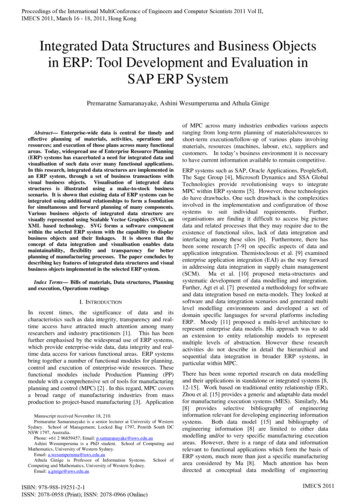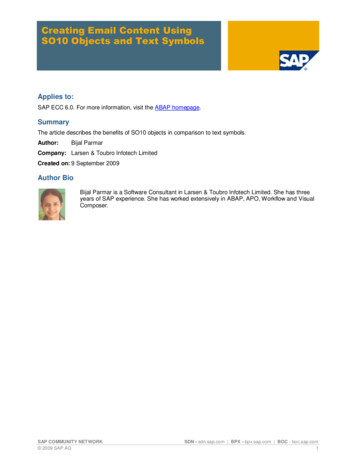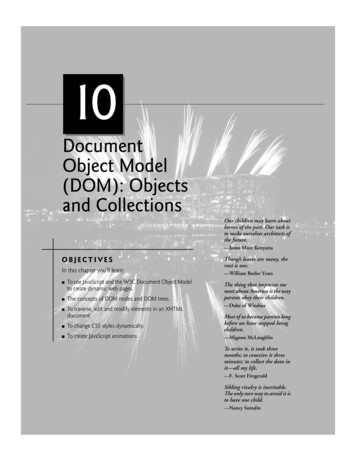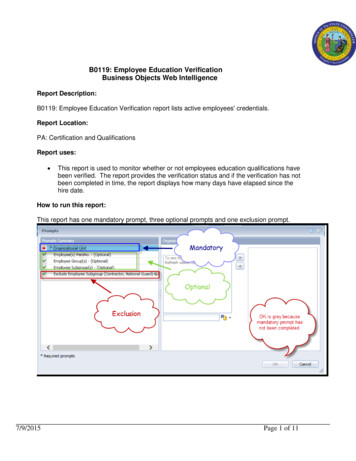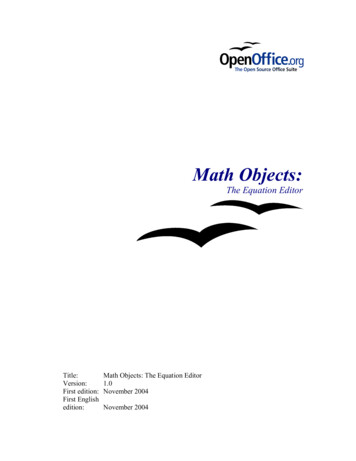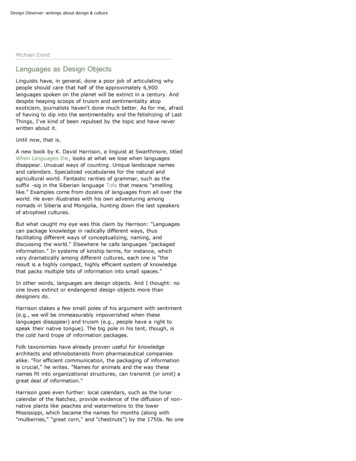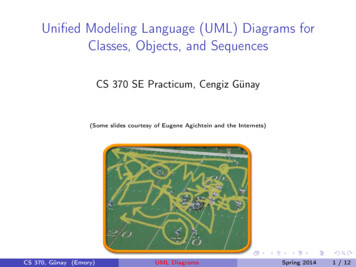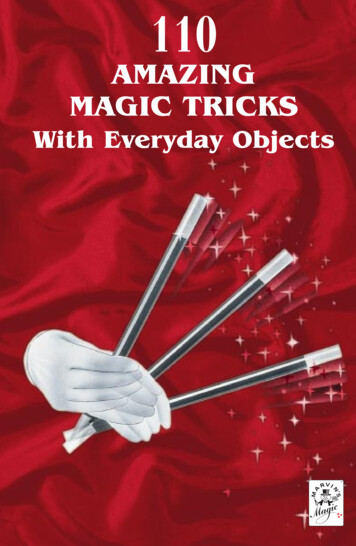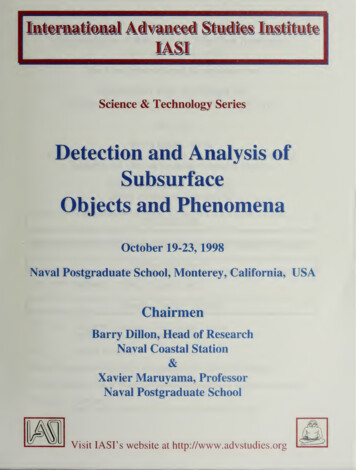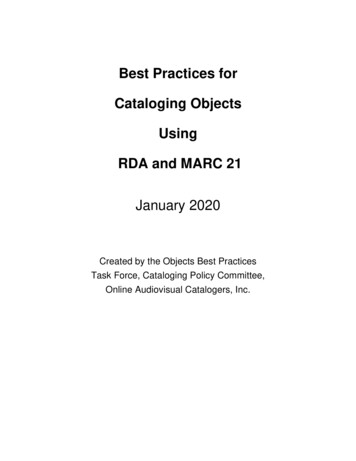
Transcription
Best Practices forCataloging ObjectsUsingRDA and MARC 21January 2020Created by the Objects Best PracticesTask Force, Cataloging Policy Committee,Online Audiovisual Catalogers, Inc.
ContentsAcknowledgements . 9Objects Best Practices Task Force Members . 9Advisors . 9Editors . 9Special Thanks to . 9Preface . 101. Introduction . 12Purpose . 12Charge . 13Scope . 13Guiding principles . 13Sticking Points . 141. Kits. . 142. Square brackets. . 153. Using the 588 for the title devised by cataloger note. . 154. 264 1 . 15Objects-Related Definitions . 16Four Houses of Visual Materials . 182. List of Core Elements . 19RDA Core Elements . 19LC/PCC Core Elements . 203. Choice of Record, Workform, and Fixed Fields (LDR, 008) . 21Workform . 214. Bibliographic Level (Leader/07) . 28Monograph/Item. 28Collections . 285. Preferred Source of Information (RDA 2.2) . 29Preferred Source of Information . 296. Title and Statement of Responsibility . 32Title Proper (RDA 2.3.2) . 32Selecting the Title Proper . 322
Resources without a Collective Title . 36Resources Without Title . 36A Note About Square Brackets . 37Parallel Title Proper (RDA 2.3.3) . 37Parallel Other Title Information (RDA 2.3.5) . 38Variant Titles (RDA 2.3.6) . 39Statement of Responsibility (RDA 2.4) . 407. Edition (RDA 2.5) . 42Recording Edition Statement (RDA 2.5.1.4) . 42Designation of Edition (2.5.2) Core element . 42Scope (2.5.2.1) . 42Sources of Information (2.5.2.2) . 42Recording Designation of Edition (2.5.2.3) . 438. Production, Publication, Distribution, Manufacture Statements. Copyright date. (RDA2.7-2.11) . 44Background . 44Core elements . 44Published or Unpublished . 45Unpublished Items . 45Published items . 47Publication statement (RDA 2.8). 47Distribution statement (RDA 2.9) . 48Manufacture statement (RDA 2.10) . 499. Series Statement (RDA 2.12) . 51Introduction to series statements/scope . 51Series vs. Notes. 51Title proper of series (RDA 2.12.2) . 53Parallel title proper of series (RDA 2.12.3) . 54Other title information of series (RDA 2.12.4) . 54Parallel other title information of series (RDA 2.12.5) . 54Statement of responsibility relating to series (RDA 2.12.6) . 54Parallel statement of responsibility relating to series (RDA 2.12.7) . 543
ISSN of series (RDA 2.12.8) . 55Numbering within series (RDA 2.12.9). 55Subseries. 5510. Describing Carriers and Identifying Works . 56Media Type (RDA 3.2, MARC 337). 56Carrier Type (RDA 3.3, MARC 338) . 56MARC 338 (Repeatable) . 57Extent (RDA 3.4, MARC 300 a) . 57MARC 300 a . 58Dimensions (RDA 3.5, MARC 300 c) . 58MARC 300 c . 58Physical Medium (RDA 3.2, 3.5, 3.6, 3.7, 3.8, 3.9, 3.10, 3.11, 3.13, 3.14, 3.73.15,3.16.4, 3.17.3; MARC 340) . 59Other Physical Details (RDA 3.7, 3.8, 3.9, 3.11, 3.14, 3.15, 3.16, 3.17, 7.15; MARC300 b) . 62Form of Work (RDA 6.3, MARC 380). 62Content Type (RDA 6.9; MARC 336) . 6311. Notes . 65Notes on manifestation (RDA 2.17) . 65Title Source Note (RDA 2.17.2.3). 65Note on statement of responsibility (RDA 2.17.3) . 65Note on edition statement (RDA 2.17.4) . 66Note on production, publication, distribution, manufacture statement (RDA 2.17.6,2.17.7, 2.17.8, 2.17.9) . 66Note on copyright date (RDA 2.17.10) . 66Note on Carrier (RDA 3.21) . 6712. Uniform Resource Locator (RDA 4.6). 70Appendix 1: Sample MARC Records . 71Realia (Manufactured) . 71Title: Balance Pods . 71Image: Balance Pods . 72Realia (Naturally Occurring Object) . 73Title: Geode . 734
Image: Geode . 74Realia (Naturally Occurring Object, Packaged / Distributed) . 75Title: Introductory rock collection . 75Title: Introductory rock collection . 76Realia (Naturally-Occurring Object, packaged / distributed) . 78Image: Iron meteorite . 78Title: Iron meteorite . 79Realia (Naturally-Occurring Object, packaged/distributed) . 80Title: Tree Rounds Set . 80Image: Tree Rounds Set . 81Realia (Manufactured) . 83Title: Hull House pottery . 83Image: Hull House pottery . 84Realia (Handmade Item). 85Title: Justice (Banner) . 85Image: Justice (Banner) . 86Realia (Handmade Item). 87Title: Pincushion of Elizabeth Mather . 87Image: Pincushion of Elizabeth Mather . 88Realia (Handmade Items) . 89Title: Set of 12 Jamaican lace-bark doilies . 89Image: Set of 12 Jamaican lace-bark doilies . 91Realia (Manufactured, Distributed) . 94Title: Votes for Women tea cup and saucer . 94Image: Votes for Women tea cup and saucer . 95Realia (Manufactured, Distributed) . 96Title: WSPU tea set . 96Image: WSPU tea set. 97Realia (Distributed) . 98Title: Feely bag texture materials kit. 98Image: Feely bag texture materials kit . 99Toys . 1005
Title: Archiquest : the intelligent building system. Pharaohs and pyramids : Egypt’swonders . 100Image: Archiquest : the intelligent building system. Pharaohs and pyramids :Egypt’s wonders . 102Toys . 105Title: Crocodile stage puppet . 105Image: Crocodile stage puppet . 106Toys . 107Title: William Shakespeare LEGO minifigure . 107Image: William Shakespeare LEGO minifigure . 109Toys . 111Title: Juliet from the ballet Romeo and Juliet . 111Image: Juliet from the ballet Romeo and Juliet . 113Model . 116Title: Median section of male and female urinary tract . 116Image: Median section of male and female urinary tract . 117Model . 118Title: Muscular body . 118Image: Muscular body . 119Model . 120Title: Tall Paul . 120Image: Tall Paul . 121Model . 122Title: Mr. Bones human skeleton . 122Image: Mr. Bones human skeleton. 123Art Original . 124Title: Cast bronze portrait of Shakespeare . 124Image: Cast bronze portrait of Shakespeare . 126Game (Board Game) . 128Title: Rise up . 128Image: Rise up . 129Game (Board Game) . 130Title: Finca . 1306
Image: Finca . 132Game (Board Game) . 134Title: Monopoly : the classic edition. 134Image: Monopoly : the classic edition . 136Game (Board Game) . 137Title: Battleship. 137Image: Battleship . 138Game . 139Title: The original game of connect 4 . 139Image: The original game of Connect 4 . 140Game (Card Game) . 141Title: UNO . 141Image: UNO . 142Game (Card Game) . 143Title: Old maid card game . 143Image: Old maid card game . 144Game (Puzzle) . 145Title: Spell-a-puzzle. 145Image: Spell-a-puzzle . 146Game (Puzzle) . 148Title: Ravensburger puzzle . 148Image: Ravensburger puzzle . 149Microscope Slides. 151Title: Prepared slides : set 1 . 151Image: Prepared slides : set 1. 152Diorama . 155Title: Karst caves and water action model . 155Image: Karst caves and water action model . 156Diorama . 157Title: Goodnight moon diorama . 157Image: Goodnight moon diorama . 158Appendix 2: Access Points . 1597
Agents . 159Subject Analysis . 159Library of Congress Subject Headings . 159Genre/form terminologies . 162Appendix 3: Further Reading . 164Index . 1658
AcknowledgementsObjects Best Practices Task Force MembersJulie Renee Moore (Chair), California State University, FresnoRobert B. Freeborn (Co-Chair), Penn State University LibrariesScott Dutkiewicz, Clemson UniversitySarah Hovde, Folger Shakespeare LibraryJessica Janecki, David M. Rubenstein Rare Book and ManuscriptLibrary, Duke UniversityJessica J. Schomberg, Minnesota State University, MankatoTrina Soderquist, Library of CongressAdvisorsBobby Bothmann, Minnesota State University, MankatoKelley McGrath, University of OregonJay Weitz, OCLCEditorsJulie Renee Moore, California State University, FresnoRobert B. Freeborn, Penn State University LibrariesJessica Janecki, David M. Rubenstein Rare Book and ManuscriptLibrary, Duke UniversityJessica J. Schomberg, Minnesota State University, MankatoSpecial Thanks toMark K. Ehlert, University of St. Thomas9
PrefaceAs of this writing, we are in the fortieth year of the formation of OLAC (Online Audiovisual Catalogers, Inc.) by our insightful and fearless leader, Nancy B. Olson (April 10,1936 - December 24, 2018), who worked at what was then known as Mankato StateUniversity for 29 years. Mankato State provided her with numerous examples of objectsand other special formats to catalog and consider within the realm of the formercataloging rules. Her five editions of Cataloguing of Audiovisual Materials have been asteadfast go-to guide for special formats catalogers for nearly four decades, and it willbe continued by Bobby Bothmann of Minnesota State University, Mankato.Michael Gorman, editor of the Anglo-American Cataloguing Rules, 2nd ed., revised,recently described the earlier book-based cataloging rules as a “procrustean bed ofbook-based descriptive rules” [which] “meant that rules for ‘non-books’ produced oftenunhelpful records.” He went on to say that “we have come a long way since then--theterm ‘non-books’ and the attitudes it enshrined are long gone. Those ‘other’ materialsare treated on their own terms and with the deserved respect for theirvalue. Nancy Olson deserves a lot of the credit for that important change. Cataloguingcodes became more inclusive, but without the practice and teaching of those moreinclusive results that were, in many ways, led by Nancy Olson and certainly exemplifiedby her, we would not have reached the equality of treatment for all materials thatcontain recorded knowledge and information that we now enjoy.” Not only that, butNancy Olson certainly paved the way for keeping the rules for cataloging specialformats practical, first and foremost.We have now leaped into the next generation of cataloging with Resource Descriptionand Access (RDA). It is still certainly the hope of the authors and editors of this BestPractices for Cataloging Objects Using RDA and MARC 21 that we can maintain thepracticality of cataloging these objects at the core of this work.As catalogers, we make numerous cataloging decisions a day. Just as its predecessors,it is clear that the RDA: Resource Description and Access instructions were mainlyintended for textual materials, be they physical print or electronic. How does onenavigate some of the more difficult areas of describing special formats, in this case,three-dimensional objects? (Our serious Objects Task Force conversations surrounding“publication,” a very text-centric concept, come to mind as an example.) Furthermore, itis easy to feel overwhelmed in the face of all these round-peg-in-a-square-holedecisions that we must make, as special formats catalogers. This is why I always keepa sign (really, a focal point) in my office that reads the wise words of one of our sagecataloging leaders, Jay Weitz (OCLC), “Do not agonize!” We hope that this guidehelps to alleviate some of these tensions through explaining the instructions, from aspecial formats point-of-view equipped with our cataloger’s judgment, and also byproviding some excellent examples (with photographs) of these objects, along with theirMARC records.The work we do as catalogers is vital in helping our library users find the resources theyneed. The changes that I have personally witnessed in cataloging over these thirty-plusyears in the field of cataloging librarianship are impressive. Now, we await the next big10
sea change with the leap to Bibframe and Linked Data close at hand. Our future ascatalogers continues to promise to be an interesting one, as we wade out further intothe Semantic Web.Julie Renee MooreCalifornia State University, Fresno11
1. IntroductionPurposeWhy catalog objects? We catalog objects in order to make them discoverable in ourlibraries’ catalogs, so that our library users may find, identify, select, and obtain theseresources just as efficiently as any other types of resources. Many of our libraries havea wealth of these objects in their special or specialized collections and archives. Formany decades, many of these objects lingered in the dark, sitting on shelves,uncataloged. Objects are very much a part of our historical human record. In the recentfour decades, these materials have been gradually cataloged, exposing to the worldthese sometimes-impressive hidden collections. Often the objects are the jewels of ourlibraries, the parts that make each of our individual libraries special.In 1983, there was an important article in American Libraries entitled, “Equality ofCataloging in the Age of AACR2.” OLAC prepared a statement in that issue, explainingthe need for complete cataloging of audiovisual materials. It reads:Full and standard bibliographic description of non-print resourcesfacilitates: A heightened awareness of the full range of information resourcesa library offers its user population; A consistent means for both the local and remote user of thecatalog to search the entire collection through a single interface; Identification of material that represents a significant expenditure oflibrary funds; International efforts in cooperative cataloging by sharingbibliographic records in the utility databases.(“Equality of Cataloging in the Age of AACR2.” American Libraries,February 1983, p. 104.)Now that we have moved to RDA, these statements still ring true. The special formatscommunities still need to take a stand for the importance of the cataloging of specialformats, including Objects, as they are not particularly well represented in RDA. It is upto us to continue that which was started forty years ago.In looking at the names of the authors of this document and the places from which theyhail, there is certainly a reason why most of these esteemed catalogers from variousspecial collections, specialized collections, and archives were drawn to this particulartask force. We are all eager to bring out the very best from these collections of specialformats, objects, in this case. Throughout the
9 Acknowledgements Objects Best Practices Task Force Members Julie Renee Moore (Chair), California State University, Fresno Robert B. Freeborn (Co-Chair), Penn State University Libraries Scott Dutkiewicz, Clemson University Sarah Hovde, Folger Shakespeare Library Jessica Janecki, David M. Rubenstein Rare



